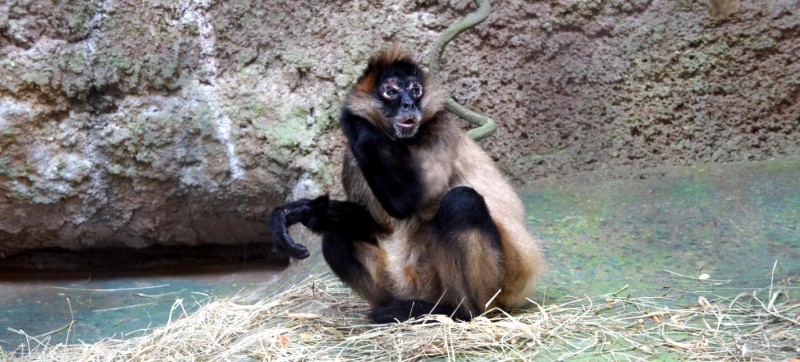Black-Handed Spider Monkey - Ateles geoffroyi



Habitat:
This includes rainforests, semi-deciduous forests and mangrove forests. Higher densities of monkeys appear to be found in areas containing evergreen forest. They mostly inhabit the upper portion of the forest.
Range:
Its range encompasses Panama, Costa Rica, Nicaragua, Guatemala, Honduras, El Salvador, Belize, and Mexico.
Activity Cycle:
Diurnal
Features:
The body color varies by population between buff and black. Usually the forearms, hands, lower legs and feet are dark or black. The face usually has a pale mask around the eyes and muzzle
Size:
Its length measures between 12 and 25 in and it weighs between 13 and 20 lb. The prehensile tail is longer than the body at between 25 and 33 in. Males are slightly larger than females.
Social Structure:
They are gregarious and live in medium sized, loosely associated groups with an average group size of from 20 to 42 members, depending on the population. They groom one another to increase social bonds. They forage in subgroups between 1-6 individual.
Life Expectancy:
On average up to 27 years, but can live longer.
Diet:
Monkeys primarily eats fruit, preferably ripe, fleshy fruit. Other elements of its diet include flowers, bark, leaves, insects and honey. Fruit makes up about 75% of their diet, when fruit is scarce they eat leaves.
Reproduction:
Female Spider Monkeys only bear young every two to four years. The gestational period is about 7.5 months, after which a single young is typically born. They are cared for only by their mother. Females are sexually mature between 4-5 years of age and males are mature at 5 years old. Babies are born entirely black and cling to mom’s stomach until 5 months old. Then it climbs on her back. This is when adult coloration starts occurring. They are dependent on mom’s milk for 2 years.
Status:
Are listed as endangered under the IUCN Red List and with the USFWS. They are under appendix II of CITES and are part of an AZA Species Survival Plan.
Interesting Facts:
- The prehensile tail is very strong and has a palm-like pad at the end. The pad acts like a palm. This bare sensory area allows it to grip and the skin on that area is like a fingerprint unique to each monkey.
- A study performed in 2007 concluded that spider monkeys were the third most intelligent non-human primate.
- Geoffroy’s Spider Monkey sometimes rubs a mixture of saliva and ground lime tree Citrus aurantifolia leaves on their fur. This is believed to act as an insect repellent.
- Many animals benefit from fruit dropped by these primates.
- Are almost completely arboreal.
- Females have a more active leading role than males.
- Their arms are longer than their legs.

AZA cooperatively manages this species as a Species Survival Plan® Program.
Video:
Prices
- Adult (13 and over)$12.50
- Child (2 - 12)$9.00
- Child (1 and Under)FREE
- Senior (65+)$11.50
- Active Military$11.50
We begin transferring animals to evening (off exhibit) holding at 4:30 each night.
Find Us
2320 N. Prospect Rd.
Peoria, IL 61603
Phone: 309-686-3365
Open Daily 10:00-5:00
Last admission at 4:30
